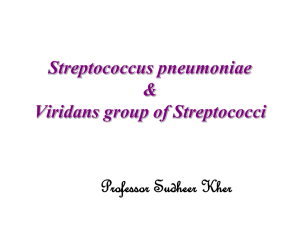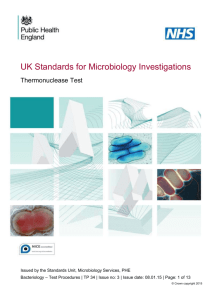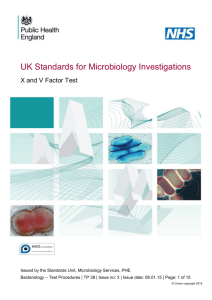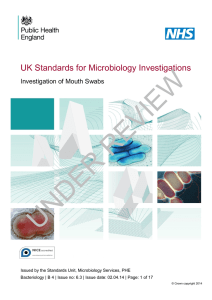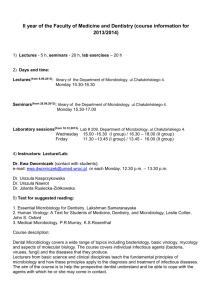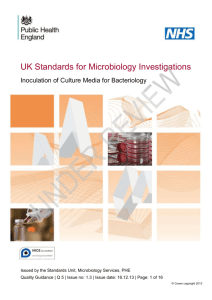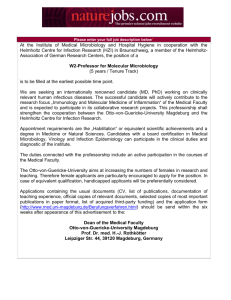TP 25i3 January 2015: issued
advertisement
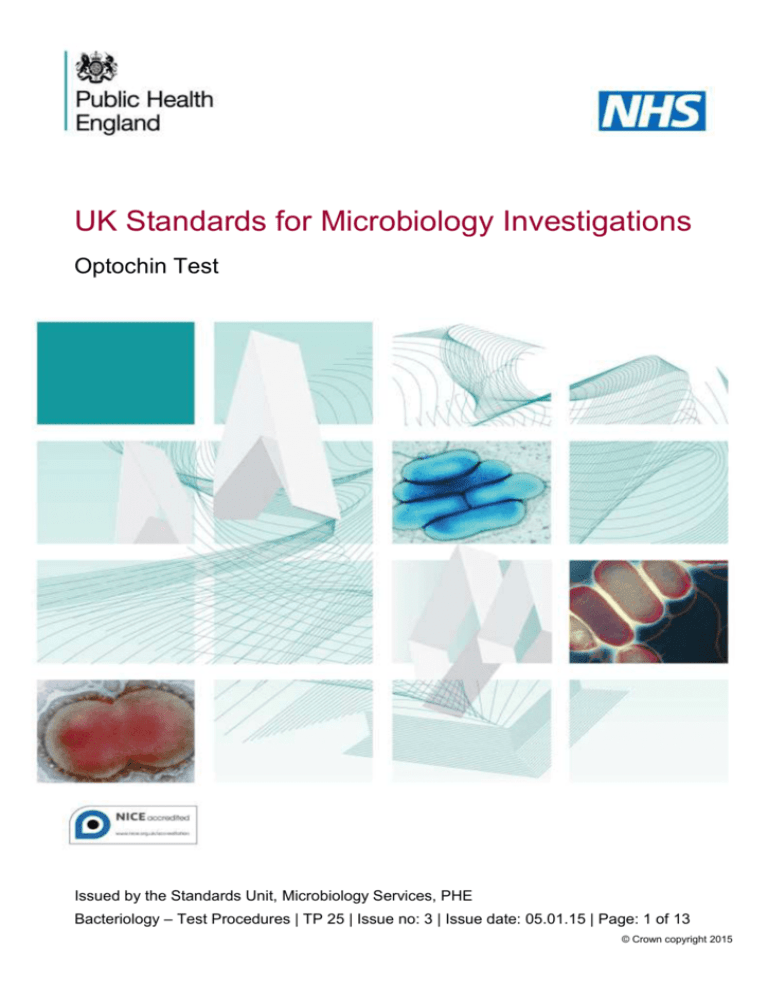
UK Standards for Microbiology Investigations Optochin Test Issued by the Standards Unit, Microbiology Services, PHE Bacteriology – Test Procedures | TP 25 | Issue no: 3 | Issue date: 05.01.15 | Page: 1 of 13 © Crown copyright 2015 Optochin Test Acknowledgments UK Standards for Microbiology Investigations (SMIs) are developed under the auspices of Public Health England (PHE) working in partnership with the National Health Service (NHS), Public Health Wales and with the professional organisations whose logos are displayed below and listed on the website https://www.gov.uk/ukstandards-for-microbiology-investigations-smi-quality-and-consistency-in-clinicallaboratories. SMIs are developed, reviewed and revised by various working groups which are overseen by a steering committee (see https://www.gov.uk/government/groups/standards-for-microbiology-investigationssteering-committee). The contributions of many individuals in clinical, specialist and reference laboratories who have provided information and comments during the development of this document are acknowledged. We are grateful to the Medical Editors for editing the medical content. For further information please contact us at: Standards Unit Microbiology Services Public Health England 61 Colindale Avenue London NW9 5EQ E-mail: standards@phe.gov.uk Website: https://www.gov.uk/uk-standards-for-microbiology-investigations-smi-qualityand-consistency-in-clinical-laboratories UK Standards for Microbiology Investigations are produced in association with: Logos correct at time of publishing. Bacteriology – Test Procedures | TP 25 | Issue no: 3 | Issue date: 05.01.15 | Page: 2 of 13 UK Standards for Microbiology Investigations | Issued by the Standards Unit, Public Health England Optochin Test Contents ACKNOWLEDGMENTS .......................................................................................................... 2 CONTENTS ............................................................................................................................. 3 AMENDMENT TABLE ............................................................................................................. 4 UK STANDARDS FOR MICROBIOLOGY INVESTIGATIONS: SCOPE AND PURPOSE ....... 5 SCOPE OF DOCUMENT ......................................................................................................... 8 INTRODUCTION ..................................................................................................................... 8 TECHNICAL INFORMATION/LIMITATIONS ........................................................................... 8 1 SAFETY CONSIDERATIONS ...................................................................................... 9 2 REAGENTS AND EQUIPMENT ................................................................................... 9 3 QUALITY CONTROL ORGANISMS ............................................................................ 9 4 PROCEDURE AND RESULTS..................................................................................... 9 APPENDIX: OPTOCHIN TEST .............................................................................................. 11 REFERENCES ...................................................................................................................... 12 Bacteriology – Test Procedures | TP 25 | Issue no: 3 | Issue date: 05.01.15 | Page: 3 of 13 UK Standards for Microbiology Investigations | Issued by the Standards Unit, Public Health England Optochin Test Amendment Table Each SMI method has an individual record of amendments. The current amendments are listed on this page. The amendment history is available from standards@phe.gov.uk. New or revised documents should be controlled within the laboratory in accordance with the local quality management system. Amendment No/Date. 6/05.01.15 Issue no. discarded. 2.3 Insert Issue no. 3 Section(s) involved Amendment Whole document. Hyperlinks updated to gov.uk. Page 2. Updated logos added. Introduction. This section has been updated and references added. Technical information/Limitations. This section has been updated and references added. Safety Considerations. References updated. Reagents/Equipment. This section has been updated. Quality Control Organisms. The quality control organisms have been validated by NCTC. Procedures and Results. References added. References. Some references updated. Bacteriology – Test Procedures | TP 25 | Issue no: 3 | Issue date: 05.01.15 | Page: 4 of 13 UK Standards for Microbiology Investigations | Issued by the Standards Unit, Public Health England Optochin Test UK Standards for Microbiology Investigations: Scope and Purpose Users of SMIs SMIs are primarily intended as a general resource for practising professionals operating in the field of laboratory medicine and infection specialties in the UK. SMIs provide clinicians with information about the available test repertoire and the standard of laboratory services they should expect for the investigation of infection in their patients, as well as providing information that aids the electronic ordering of appropriate tests. SMIs provide commissioners of healthcare services with the appropriateness and standard of microbiology investigations they should be seeking as part of the clinical and public health care package for their population. Background to SMIs SMIs comprise a collection of recommended algorithms and procedures covering all stages of the investigative process in microbiology from the pre-analytical (clinical syndrome) stage to the analytical (laboratory testing) and post analytical (result interpretation and reporting) stages. Syndromic algorithms are supported by more detailed documents containing advice on the investigation of specific diseases and infections. Guidance notes cover the clinical background, differential diagnosis, and appropriate investigation of particular clinical conditions. Quality guidance notes describe laboratory processes which underpin quality, for example assay validation. Standardisation of the diagnostic process through the application of SMIs helps to assure the equivalence of investigation strategies in different laboratories across the UK and is essential for public health surveillance, research and development activities. Equal Partnership Working SMIs are developed in equal partnership with PHE, NHS, Royal College of Pathologists and professional societies. The list of participating societies may be found at https://www.gov.uk/uk-standards-formicrobiology-investigations-smi-quality-and-consistency-in-clinical-laboratories. Inclusion of a logo in an SMI indicates participation of the society in equal partnership and support for the objectives and process of preparing SMIs. Nominees of professional societies are members of the Steering Committee and Working Groups which develop SMIs. The views of nominees cannot be rigorously representative of the members of their nominating organisations nor the corporate views of their organisations. Nominees act as a conduit for two way reporting and dialogue. Representative views are sought through the consultation process. SMIs are developed, reviewed and updated through a wide consultation process. Microbiology is used as a generic term to include the two GMC-recognised specialties of Medical Microbiology (which includes Bacteriology, Mycology and Parasitology) and Medical Virology. Bacteriology – Test Procedures | TP 25 | Issue no: 3 | Issue date: 05.01.15 | Page: 5 of 13 UK Standards for Microbiology Investigations | Issued by the Standards Unit, Public Health England Optochin Test Quality Assurance NICE has accredited the process used by the SMI Working Groups to produce SMIs. The accreditation is applicable to all guidance produced since October 2009. The process for the development of SMIs is certified to ISO 9001:2008. SMIs represent a good standard of practice to which all clinical and public health microbiology laboratories in the UK are expected to work. SMIs are NICE accredited and represent neither minimum standards of practice nor the highest level of complex laboratory investigation possible. In using SMIs, laboratories should take account of local requirements and undertake additional investigations where appropriate. SMIs help laboratories to meet accreditation requirements by promoting high quality practices which are auditable. SMIs also provide a reference point for method development. The performance of SMIs depends on competent staff and appropriate quality reagents and equipment. Laboratories should ensure that all commercial and in-house tests have been validated and shown to be fit for purpose. Laboratories should participate in external quality assessment schemes and undertake relevant internal quality control procedures. Patient and Public Involvement The SMI Working Groups are committed to patient and public involvement in the development of SMIs. By involving the public, health professionals, scientists and voluntary organisations the resulting SMI will be robust and meet the needs of the user. An opportunity is given to members of the public to contribute to consultations through our open access website. Information Governance and Equality PHE is a Caldicott compliant organisation. It seeks to take every possible precaution to prevent unauthorised disclosure of patient details and to ensure that patient-related records are kept under secure conditions. The development of SMIs are subject to PHE Equality objectives https://www.gov.uk/government/organisations/public-health-england/about/equalityand-diversity. The SMI Working Groups are committed to achieving the equality objectives by effective consultation with members of the public, partners, stakeholders and specialist interest groups. Legal Statement Whilst every care has been taken in the preparation of SMIs, PHE and any supporting organisation, shall, to the greatest extent possible under any applicable law, exclude liability for all losses, costs, claims, damages or expenses arising out of or connected with the use of an SMI or any information contained therein. If alterations are made to an SMI, it must be made clear where and by whom such changes have been made. The evidence base and microbial taxonomy for the SMI is as complete as possible at the time of issue. Any omissions and new material will be considered at the next review. These standards can only be superseded by revisions of the standard, legislative action, or by NICE accredited guidance. SMIs are Crown copyright which should be acknowledged where appropriate. Bacteriology – Test Procedures | TP 25 | Issue no: 3 | Issue date: 05.01.15 | Page: 6 of 13 UK Standards for Microbiology Investigations | Issued by the Standards Unit, Public Health England Optochin Test Suggested Citation for this Document Public Health England. (2015). Optochin Test. UK Standards for Microbiology Investigations. TP 25 Issue 3. https://www.gov.uk/uk-standards-for-microbiologyinvestigations-smi-quality-and-consistency-in-clinical-laboratories Bacteriology – Test Procedures | TP 25 | Issue no: 3 | Issue date: 05.01.15 | Page: 7 of 13 UK Standards for Microbiology Investigations | Issued by the Standards Unit, Public Health England Optochin Test Scope of Document Susceptibility to optochin is a simple and reliable method of differentiating Streptococcus pneumoniae from other alpha-haemolytic streptococci1. This SMI should be used in conjunction with other SMIs. Introduction Optochin is a chemical, ethylhydrocupreine hydrochloride and is completely soluble in water. The optochin test detects an organism’s susceptibility to the chemical optochin. The chemical tests the fragility of the bacterial cell membrane and causes S. pneumoniae to lyse due to changes in surface tension2. The optochin test is widely used in the form of filter paper discs, impregnated with ethylhydrocupreine hydrochloride, which are applied directly to inoculated plates before incubation3,4. The optochin test is less time-consuming than the bile solubility test4. Technical Information/Limitations Optochin discs are stable, either refrigerated (4°C) or stored at room temperature (25°C). However, it is recommended that they be kept refrigerated at all times when not in use but their length of stability will differ with different manufacturers. They should also be given a quality control check and be removed when they demonstrate a negative or weak reaction with a known sensitive S. pneumoniae strain4. Some “viridans” streptococci may produce a small zone of inhibition, ie <14mm 5. Occasional strains of optochin resistant S. pneumoniae have been reported. In cases where an alpha-haemolytic streptococcus is found to be resistant to optochin or produce a small zone, a bile solubility test should be carried out for confirmation 5. False resistant results may be reported if cultures are incubated in high concentrations of CO2. S. pneumoniae grown in less than 5% CO2 have smaller zones of inhibition6. Bacteriology – Test Procedures | TP 25 | Issue no: 3 | Issue date: 05.01.15 | Page: 8 of 13 UK Standards for Microbiology Investigations | Issued by the Standards Unit, Public Health England Optochin Test Safety Considerations7-23 1 Refer to current guidance on the safe handling of all organisms and reagents documented in this UK Standards for Microbiology Investigation. All work likely to generate aerosols must be performed in a microbiological safety cabinet. The above guidance should be supplemented with local COSHH and risk assessments. Compliance with postal and transport regulations is essential. 2 Reagents and Equipment Suitable agar plate Filter paper discs impregnated with 5µg of ethylhydrocupreine hydrochloride Bacteriological straight wire/loop or disposable alternative Sterile forceps or sterile applicator 3 Quality Control Organisms Positive Control Streptococcus pneumoniae NCTC 12977 Negative Control Streptococcus mitis NCTC 10712 Note: These strains are validated by NCTC to give this result. The positive and negative controls should be tested alongside the test organism. This aids in interpretation of results. 4 Procedure and Results 4.1 Pure Colony2 Streak a suitable agar plate with the organism to be tested Using a sterile forceps or a sterile applicator, place an optochin disc in the centre of the inoculum and gently apply pressure to adhere to the surface of the plate Incubate at 35-37°C for 18-24hr in 5% CO2 Examine for zones of inhibition 4.2 Specimen1,6 Streak the specimen on a suitable agar plate Place an optochin disc on the edge of the primary inoculum Incubate at 35-37°C for 18-24hr in 5% CO2 Bacteriology – Test Procedures | TP 25 | Issue no: 3 | Issue date: 05.01.15 | Page: 9 of 13 UK Standards for Microbiology Investigations | Issued by the Standards Unit, Public Health England Optochin Test Examine for zones of inhibition Note: Optochin discs may be used in the direct examination of clinical specimens eg sputa. Interpretation Sensitive Zone of inhibition of ≥14mm diameter/clear zone around disk indicate test organism is S. pneumoniae. Organisms with borderline diameters should only be considered by another test. Resistant No zone of inhibition or a zone of inhibition of <14mm diameter/Growth up to and around disk indicates test organism is not S. pneumoniae. See Technical Information section for further test requirements. Note: The terms sensitive or resistant must be used for interpretations of the optochin test and never positive or negative as these do not explain the results sufficiently; it could mean inhibited growth or simply that the organism grew on blood agar but did not react with optochin2. Bacteriology – Test Procedures | TP 25 | Issue no: 3 | Issue date: 05.01.15 | Page: 10 of 13 UK Standards for Microbiology Investigations | Issued by the Standards Unit, Public Health England Optochin Test Appendix: Optochin Test Pure colony Specimen Streak a suitable agar plate with organism to be tested. Place optochin disc in centre / edge of the inoculum Incubate at 35-37°C for 18-24hr in 5% CO2 Sensitive Zone of inhibition of ≥ 14mm radius from the edge of disc Resistant No zone of inhibition or <14mm Note: Positive control Streptococcus pneumoniae NCTC 12977 Negative control Streptococcus mitis NCTC 10712 The flowchart is for guidance only. Bacteriology – Test Procedures | TP 25 | Issue no: 3 | Issue date: 05.01.15 | Page: 11 of 13 UK Standards for Microbiology Investigations | Issued by the Standards Unit, Public Health England Optochin Test References 1. Ross PW. Streptococcus Pneumoniae. In: Collee JG, Fraser AG, Marmion BP, Simmons A, editors. Mackie & McCartney Practical Medical Microbiology. 14th ed. Edinburgh: Churchill Livingstone; 1996. p. 275-81. 2. MacFaddin JF. Optochin Disk Test. Biochemical Tests for Identification of Medical Bacteria. 3rd ed. Philadelphia: Lippincott Williams and Wilkins; 2000. p. 363-7. 3. Barrow GI, Feltham RKA, editors. Cowan and Steel's Manual for the Identification of Medical Bacteria. 3rd ed. Cambridge: Cambridge University Press; 1993. p. 33 4. Bowers EF, Jeffries LR. Optochin in the identification of str. pneumoniae. J Clin Pathol 1955;8:5860. 5. Pikis A, Campos JM, Rodriguez WJ, Keith JM. Optochin resistance in Streptococcus pneumoniae: mechanism, significance, and clinical implications. J Infect Dis 2001;184:582-90. 6. Ragsdale AR, Sanford JP. Interfering effect of incubation in carbon dioxide on the identification of pneumococci by optochin discs. Appl Microbiol 1971;22:854-5. 7. European Parliament. UK Standards for Microbiology Investigations (SMIs) use the term "CE marked leak proof container" to describe containers bearing the CE marking used for the collection and transport of clinical specimens. The requirements for specimen containers are given in the EU in vitro Diagnostic Medical Devices Directive (98/79/EC Annex 1 B 2.1) which states: "The design must allow easy handling and, where necessary, reduce as far as possible contamination of, and leakage from, the device during use and, in the case of specimen receptacles, the risk of contamination of the specimen. The manufacturing processes must be appropriate for these purposes". 8. Official Journal of the European Communities. Directive 98/79/EC of the European Parliament and of the Council of 27 October 1998 on in vitro diagnostic medical devices. 7-12-1998. p. 1-37. 9. Health and Safety Executive. Safe use of pneumatic air tube transport systems for pathology specimens. 9/99. 10. Department for transport. Transport of Infectious Substances, 2011 Revision 5. 2011. 11. World Health Organization. Guidance on regulations for the Transport of Infectious Substances 2013-2014. 2012. 12. Home Office. Anti-terrorism, Crime and Security Act. 2001 (as amended). 13. Advisory Committee on Dangerous Pathogens. The Approved List of Biological Agents. Health and Safety Executive. 2013. p. 1-32 14. Advisory Committee on Dangerous Pathogens. Infections at work: Controlling the risks. Her Majesty's Stationery Office. 2003. 15. Advisory Committee on Dangerous Pathogens. Biological agents: Managing the risks in laboratories and healthcare premises. Health and Safety Executive. 2005. 16. Advisory Committee on Dangerous Pathogens. Biological Agents: Managing the Risks in Laboratories and Healthcare Premises. Appendix 1.2 Transport of Infectious Substances Revision. Health and Safety Executive. 2008. Bacteriology – Test Procedures | TP 25 | Issue no: 3 | Issue date: 05.01.15 | Page: 12 of 13 UK Standards for Microbiology Investigations | Issued by the Standards Unit, Public Health England Optochin Test 17. Centers for Disease Control and Prevention. Guidelines for Safe Work Practices in Human and Animal Medical Diagnostic Laboratories. MMWR Surveill Summ 2012;61:1-102. 18. Health and Safety Executive. Control of Substances Hazardous to Health Regulations. The Control of Substances Hazardous to Health Regulations 2002. 5th ed. HSE Books; 2002. 19. Health and Safety Executive. Five Steps to Risk Assessment: A Step by Step Guide to a Safer and Healthier Workplace. HSE Books. 2002. 20. Health and Safety Executive. A Guide to Risk Assessment Requirements: Common Provisions in Health and Safety Law. HSE Books. 2002. 21. Health Services Advisory Committee. Safe Working and the Prevention of Infection in Clinical Laboratories and Similar Facilities. HSE Books. 2003. 22. British Standards Institution (BSI). BS EN12469 - Biotechnology - performance criteria for microbiological safety cabinets. 2000. 23. British Standards Institution (BSI). BS 5726:2005 - Microbiological safety cabinets. Information to be supplied by the purchaser and to the vendor and to the installer, and siting and use of cabinets. Recommendations and guidance. 24-3-2005. p. 1-14 Bacteriology – Test Procedures | TP 25 | Issue no: 3 | Issue date: 05.01.15 | Page: 13 of 13 UK Standards for Microbiology Investigations | Issued by the Standards Unit, Public Health England
